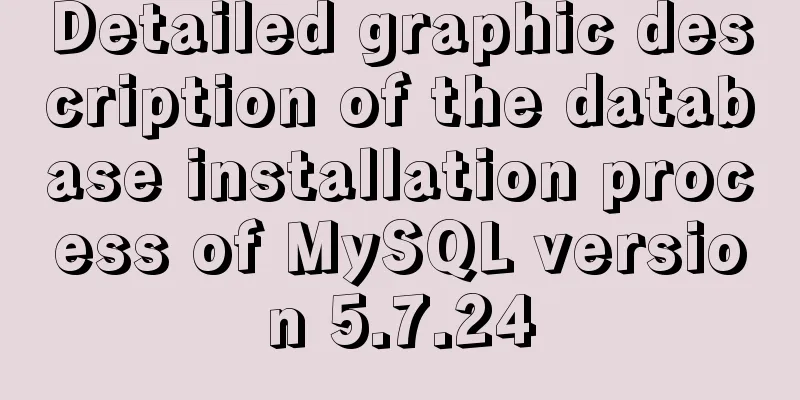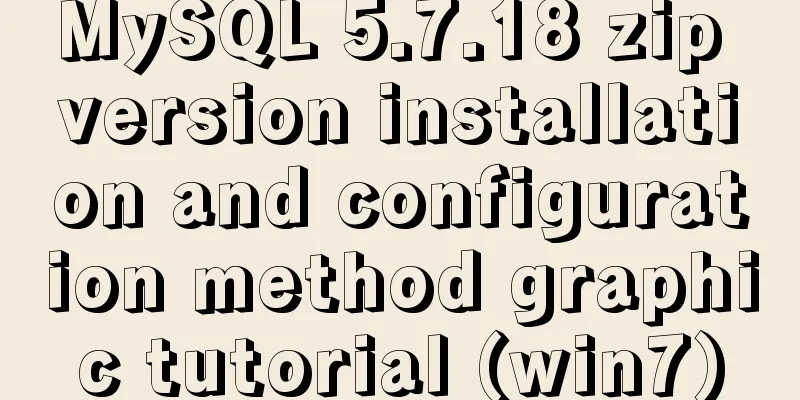Detailed graphic description of the database installation process of MySQL version 5.7.24

|
MySQL is the most popular relational database management system. In terms of WEB applications, MySQL is one of the best RDBMS (Relational Database Management System) application software. 1: Download the MySQL installation package Open the website to download MySQL (MySQL download address link) The default link to this website is the latest version of MySQL, so if you need to download version 5.7, you need to click the link in the picture below to download it.
Select the version that corresponds to your computer, which is generally a 64-bit computer.
Next, click Download and select No thanks, just start my download to download the installation package directly. 2: Unzip to the corresponding folder The downloaded file is a compressed file, unzip it to the directory you want to put it in.
Configure MySQL environment variables, system variables--->New---->Variable name MYSQL_HOME, variable value is your path name My variable name is: C:\MySQL\mysql-5.7.24-winx64 Then change the Path environment variable and add the following value: %MYSQL_HOME%\bin Three: my.ini file There is no data folder and my.ini file in the folder you unzipped, so add an empty data folder and a my.ini file. The contents of the my.ini file are as follows [mysql] # Set the default character set of the mysql client to default-character-set=utf8 [mysqld] #Set port 3306 port = 3306 # Set the installation directory of mysql to basedir=C:\MySQL\mysql-5.7.24-winx64 # Set the storage directory of MySQL database data datadir=C:\MySQL\mysql-5.7.24-winx64\data # Maximum number of connections allowed max_connections=200 # The default character set used by the server is the 8-bit latin1 character set character-set-server=utf8 # The default storage engine that will be used when creating a new table default-storage-engine=INNODB
Four: Install MySQL service and initialize Run cmd as an administrator and execute the command to install the mysql service: mysqld install We can see that the service has been successfully installed. If the installation fails, it may be because you installed it before but did not uninstall it completely, so be sure to uninstall it completely.
Then execute the mysql initialization command: msqld --initialize
Execute this command and start our mysql: net start mysql
The following errors may occur here
The solution is to enter our MySQL decompression package, delete the data folder, and then re-execute the command: mysqld --initialize Execute After successful startup, we log in. Since there is a default password during initialization, where can we find the default password? In the file ending with err under our data folder.
Execute the command: mysql -u root -p Enter the password found above: EcpHl,h33/N), then log in and change the default root password: alter user root@localhost identified by '123456'; Finally, let’s talk about how to set the username and password for remote connection: We use Navicat for user management. When adding a new user, you can see the host input box. When setting it up, if you want the user to be able to connect remotely, please enter %. If it is for local connection, please enter localhost
Summarize The above is a graphic and detailed explanation of the database installation process of MySQL version 5.7.24 introduced by the editor. I hope it will be helpful to everyone. If you have any questions, please leave me a message and the editor will reply to you in time. I would also like to thank everyone for their support of the 123WORDPRESS.COM website! You may also be interested in:
|
<<: Detailed explanation of nmcli usage in CentOS8
>>: 6 ways to implement the maximum and minimum values of an array in javascript
Recommend
How to use flat style to design websites
The essence of a flat website structure is simpli...
React-native sample code to implement the shopping cart sliding deletion effect
Basically all e-commerce projects have the functi...
Zabbix's psk encryption combined with zabbix_get value
Since Zabbix version 3.0, it has supported encryp...
Analyze the working principle of Tomcat
SpringBoot is like a giant python, slowly winding...
New ways to play with CSS fonts: implementation of colored fonts
What if you designers want to use the font below ...
How to enable remote access permissions in MYSQL
1. Log in to MySQL database mysql -u root -p View...
Installation of mysql-community-server. 5.7.18-1.el6 under centos 6.5
Use the following command to check whether MySQL ...
Pure CSS to achieve input box placeholder animation and input verification
For more exciting content, please visit https://g...
Java+Tomcat environment deployment and installation process diagram
Next, I will install Java+Tomcat on Centos7. Ther...
Detailed process of modifying hostname after Docker creates a container
There is a medicine for regret in the world, as l...
Content-type description, that is, the type of HTTP request header
To learn content-type, you must first know what i...
How to create your first React page
Table of contents What is Rract? background React...
UDP simple server client code example
I won’t go into details about the theory of UDP. ...
Detailed explanation of fs module and Path module methods in Node.js
Overview: The filesystem module is a simple wrapp...
Several ways to pass data from parent components to child components in Vue
I have been studying the source code of Vue recen...




















